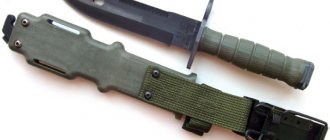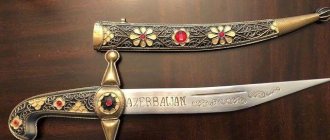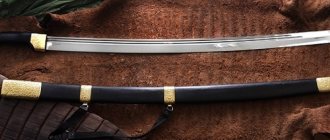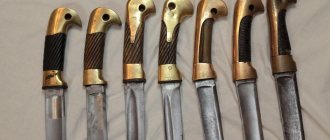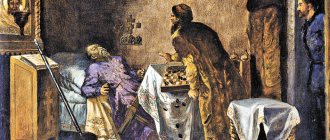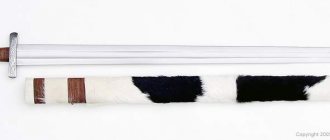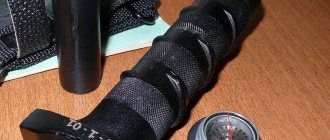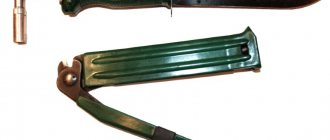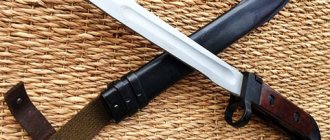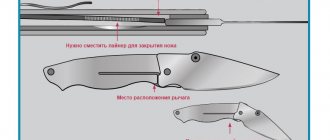Origin of the name of the saber
The word sword itself was called differently in different regions of Arab countries. The Turks called the product kilic, the Egyptians and Persians called it talwar. And the appearance of such a name as shamshir is associated with the city of the same name. Translated from Persian, the word shamshir literally meant “curved like a lion’s claw.”
A strongly curved Turkish saber that really resembles an animal's claw. If the word shamshir is translated literally, then the translation is as follows: “sword of hunters” or “sword for hunting . For this reason, hunting scenes are often engraved on blades.
Shamshir
The Persian shamshir (“lion’s tail”) was no less popular than the kilij. Many experts consider it the most successful among eastern sabers. The blade of the shamshir is more massive than that of the kilij, but narrower, with a smooth curve, without elmani. The cross section of the blade is wedge-shaped.
Shamshir
The hilt of the shamshir has a thin, round handle and a durable steel cross. The handle of the shamshir does not have a pronounced massive pommel, but is simply bent at a right angle in its upper part. Due to this specific structure, the shamshir is more difficult to hold in the hand than a Turkish saber.
Shamshir hilt
The Turks somewhat modernized the Persian shamshir: having borrowed the shape of the blade, they equipped the weapon with a familiar handle with a comfortable pommel.
Shamshir with Turkish handle
During the Egyptian campaign of 1799 - 1801. the French were able to become more closely acquainted with these two types of eastern sabers and probably appreciated their merit. In Europe at that time, they received a single name - sabers in the “Mameluke” style, which became a defined style of military fashion, like the “Circassian saber” or “Scottish broadsword.” Thus, within the framework of one type, which became known in Europe as “Mameluk”, there were sabers with typological elements inherent in both kilij and shamshirs. The French used these elements in their own weapons.
As a result, a uniform saber arose with its own set of specific characteristics.
Replica saber in Mameluke style
The blades of these sabers were about 87 cm long, strongly curved (curve 9 - 15 cm), up to 3 cm wide, usually with one wide fuller. Crosspiece with elements of the Egyptian style of the turn of the 18th - 19th centuries or classical Persian.
Mameluke uniform saber
Mameluke sabers became a popular military fashion accessory of the Romantic period. In the United Kingdom, the 1831 saber for generals and field marshals remains part of the dress uniform to this day.
Saber device
The thin blade of the Turkish saber shamshir does not taper along almost its entire length. The saber is a one-handed item. The blade is quite strongly curved.
What was the bend angle of the saber?
The bending angle starts at the base and ranges from 5 to 15 degrees.
What was the thickness of the blade?
The blade itself is 1.5 cm thick.
What is the length of the product?
The total length of the product ranges from 85 to 105 cm.
How much did the saber weigh?
The weight of the Turkish saber reaches 1 kg.
The product was worn in a horizontal position. The saber was useless against heavy or plate armor. There was no need to go against the cavalry at all.
It is very difficult to stab with a curved blade. The saber was intended to deliver a cutting blow with a drawbar.
This was typical for the peoples of Asia. Metal parts were sometimes decorated with carvings. They were also inlaid with stones or covered with enamel.
But these are rather beautiful exceptions; much more often the saber looks simple, without decoration. The blades of the sabers were made of Damascus or damask steel. The scabbard for the saber was made of ivory or wood.
Examples of Turkish shamshir sabers.
Turkish saber kilic
For a long time, the word kilic was used to describe any Turkish edged weapon. But this specific name was given to a peculiar blade. The first third of which is straight, and already from the second third the bend begins.
What is the length of the blade of the Kilic saber?
The length of the blade reached 85-90 cm.
What is the width of the blade?
Its width at the heel was 5 cm, and in the elmani area it reached 8 cm.
At the dawn of the Ottoman Empire, in the mid-16th century, the curve of the blade was very pronounced. Slightly later versions of the weapon received a smoother descent to the tip. The handle of the Turkish saber kilic was made of wood or animal horn.
Which was attached to the shank with rivets. The handle in the first versions of the weapon was simply beveled at the pommel. But later a distinctive feature appeared : the end of the handle began to resemble a kind of comma expanding towards the end.
The crosspiece was made of steel; it was most often straight; in rare examples it was curved. It was often gilded or covered with ornaments. There are specimens that were turned into a real work of art .
They made gold incisions, ornate designs, and decorated them with suras from the Koran. Such products became objects of worship.
The perfectly balanced blade had a center of gravity at the hilt. The product had excellent cutting qualities.
The weapon was considered universal; it was used by horsemen and infantry. As a result of numerous wars, the blade became widespread. He was known in Austria, Hungary, Poland and even in Russia. The Zaporozhye Cossacks appreciated the saber very well.
Turkish saber kilic.
Combat knives and daggers of the Indo-Persian region
Several years ago, the interesting website porco.ru was closed. It contained many publications of a male chauvinistic nature, including some about bladed weapons. Surprisingly, for a non-specialized resource, what was written was reliable, but written in a very peculiar way. The last article in the trilogy about knives and daggers of the Indo-Persian style was published on April 4, 2011. I decided to re-publish it, preserving the text and illustrations of the original, but adding navigation for convenience.
| Kard Peshkabz Karud and chura Khyber knife Pichangatti Aida-Kutti and Moplah Sword Kukri | Kerala Singal Pihia Chilanum Hanjarli Bichwa |
First, let's define geography. As a rule, the Indo-Persian region includes, in addition to India and Iran (Persia), also the territories of Afghanistan, Pakistan and Bangladesh. Note also that neighboring regions, such as Turkey, the Middle East, the Caucasus and Central Asia, are under quite strong cultural influence.
The region's population consists of many different peoples, who have long been united by a common history, as well as close trade and cultural ties. Such ethnocultural diversity and interpenetration led to the emergence of a completely indescribable abundance of forms and types of bladed weapons, which were used in battle, hunting, and in the household.
And now we will try to understand this wealth. But not in everything, but, so as not to overstrain, only in knives and daggers.
So, knives and daggers of the Indo-Persian region:
Card
Let's start our review with the simplest, one might say, classic knife, which is also simply called card
.
This knife is the most common in the region. Moreover, its distribution area includes former Turkish possessions in the Balkans, Turkey itself, the Middle East, the Caucasus and Central Asia.
For example, a Turkish card with an agate handle:
The card has a straight blade, slightly widening towards the handle, with a straight, thick, often beautifully decorated spine. Cards are usually decorated with gold, less often with silver koftgari notching.
There is no crosshair. The handle of the blade is narrower and widens towards the end. It is most often made from voluminous applied horn or bone cheeks, riveted onto the shank.
Indian cards, especially from Rajasthan, are often all-metal.
The scabbard is conical, leather, sometimes lined with silk. The card is immersed in them for almost two-thirds of the handle.
The size of the knife is on average up to 30-35 cm, but there are also longer cards. Despite its “peaceful” appearance and origin from ordinary households. everyday life knife, card is a serious military weapon. Essentially, this is a single-edged dagger designed for stabbing. The combat purpose of some cards is obvious: to increase penetration ability, they were made with a reinforced tip of the blade, which made their thickened tip shaped like an armor-piercing bullet.
Finishing the conversation about cards, I will add that for the manufacture of their blades (and not only them), as a rule, Damascus and damask steel were used, or, as it was also called in the Indo-Persian region, wootz.
Some advanced blacksmiths could make a “chevron” damascus like this:
Peshkabz
to the begining
Now let's move on to a whole family of other equally famous single-edged dagger knives called peshkabz
.
As Dr. T. Capwell writes, “ The term peshkabz originally referred to the front of the belt worn by the Persians during wrestling matches. The use of this word to refer to a dagger means that the peshkabz was worn on the front, in contrast to the khanjar and qarda, which were worn on the right and left side respectively
«.
The main distinguishing feature of all peshkabzes is the very wide spine of the blade, which is necessary so that this blade can deliver powerful piercing blows that pierce armor. After all, the main function of peshkabz is armor-piercing. They are designed to penetrate chainmail armor (plus, at a minimum, a thick quilted robe) - the most common armor of the Indo-Persian region.
To achieve the required width of the butt and at the same time reduce the weight of the knife, its blade was made thinner on both sides immediately below the butt so that its thickness was 1.5-2 mm
So the blade of the peshkabz acquired a T-shaped section. Otherwise, having such a wide spine and wedge-shaped section, the blade would be much heavier.
According to the existing tradition, knives with blades having a T-shaped section are classified as peshkabs.
However, there are a number of differences according to which such knives are divided into: peshkabz, karud and churu.
Actually, the peshkabz differs from others in its curved blade.
The butt of the peshkabz, like the butt of the card, is often decorated with koftgari or engraving.
A long curved blade, wide at the handle, gradually tapers and has a very narrow tip, and sometimes a one-and-a-half sharpening.
Blades with a flared end are often found.
The handle is made of two applied cheeks, usually made of bone, jade or horn. The back of the handle is often curved, especially in peshkabzes with strongly curved blades.
The groove for the fingers is quite deep, so that the knife is comfortable to hold even with a strong blow.
The sheath follows the shape of the blade, with the entire handle protruding from it. Average size 35-45 cm.
While I was looking for pictures on the topic, I came across this peshkabz multitool, in the hollow handle of which the Indian master placed a whole set of tools:
Moreover, each tool fits tightly into its niche, so that when the “multi-tool” is assembled, nothing clinks anywhere.
Before moving on to the karud and chura, I will provide one more picture. Very beautiful Damascus peshkabz from India:
He, along with two zira-bouk daggers (Zirah-Bouk - literally, “chain piercer”, Mail Piercer), decorated in the same “elephant” style:
Karud and chura
to the begining
Now let's pay attention to the brothers of the peshkabza - the karud
and
chure
.
Both of them are combat knives with a straight T-shaped blade in cross-section. Distributed mainly in Northern India and Afghanistan, as well as in Central Asia.
The blades of karuda and chura, wide at the hilt, begin to narrow a couple of centimeters from the base, and this narrowing can vary from sharp, almost exponential (characteristic of chura), to more gradual (found in karuda).
Then the blade descends almost linearly to the tip. The tip of the blade, reminiscent of a faceted awl, is ideal for piercing chain mail and thick cotton robe, common in those places.
Both knives are also often decorated with floral or geometric patterns using the notch method.
As a rule, the karud differs from the chura in its larger size (on average 35–50 cm versus 30–40 cm for the chura), and a massive thick handle consisting of two cheeks, usually bone.
The handle of the chura is thinner and ends in a large beak-like protrusion, which vaguely resembles the pommel of the handle of a scimitar or checker.
The scabbard is wooden, covered with leather or velvet, most often with a metal mouth and tip. The handle of the chura “sits” deeply into the sheath, while the handle of the karuda remains open.
It should be noted here that chura and karud became widespread among Afghan tribes.
And it was precisely these combat knives that the British colonialists had to become quite familiar with, who experienced their sharpness first-hand during the three Anglo-Afghan wars.
Let us give the floor to Rudyard Kipling, that selfless singer of the British Empire, who in his poem “British Recruits” has rather gloomy lines, inspired, it seems to me, by such a deadly acquaintance:
“If you are abandoned wounded in the Afghan fields, And the Afghan women have already taken out knives, Then all you can do is beat your ashes, Put the barrel of a gun in your mouth and spread your brains. To go to the Lord God as a soldier..."
Khyber knife
to the begining
But worse than any peshkabz and karud for the English soldiers were the “Khyber knives,” those same “three-foot” Kipling knives (3 feet = 0.9144 meters).
«And then the enemy came close, hand-to-hand combat began; It was then that the soldiers learned the hard way how strong and resilient the enemy was; this fight ended in screams and lamentations, and it’s better not to remember what the three-foot knives did. The line crumpled like paper, fifty ghazis rushed forward, followed by the rest, intoxicated with victory and therefore fighting with the same fury as them. The soldier beat the hammer at the sight of dark, thick blood. They ran back, bumping into each other. The regiment ran wherever they could, just to escape these merciless knives. The officers of the last company met their death completely alone
«.
Rudyard Kipling. “Drummers of the “Advanced-rear” (1888).
The Pashtun tribes of Afridi, Waziri, Masudi, etc., residents of territories near the Khyber Pass call it “salawar scimitar”, the British call it “Khyber knife”, and for brevity we will say “ Khyber”
“, especially since calling this almost meter-long miracle a knife is somehow not very convenient. It is essentially a single-edged sword.
Khyber has a heavy straight or slightly concave scimitar blade of considerable length (from 50 to 100 cm).
The butt is most often almost straight, T-shaped in cross-section. The blade widens significantly toward the handle, so that its lower part at the base plays the role of a stop or guard. The handle is not very thick, as a rule, it is made of two horn or bone cheeks, and if the cheeks are bone, then they are often made of several pieces of bone.
The pommels of the handle are different: simple semicircular, beak-shaped, like those of a chura, or even the handle does not have a pommel. There are also such rather elaborate finials:
«If you want to know what weapon they use, I have a long knife under the bench,” said the English cavalryman and pulled out a terrifying Afghan knife with a bone handle. They can easily snatch a hand from a shoulder. It's like cutting a bar of soap in half.
«.
Rudyard Kipling. “Drummers of the “Advanced-rear” (1888).
Khyber probably came to North India during the Afghan invasions of Ahmad Shah Durrani of 1851–61 or even earlier, with the troops of the Iranian Shah Nadir, who served many Afghans, and who occupied Delhi in February 1739. Since then, Khybers have taken root in India, and now richly decorated examples can be found there.
The scabbard is conical, wooden and covered in leather or fabric, often with a long metal tip and metal mouth. The handle, as a rule, is recessed into the sheath deeply, two-thirds of the way.
The origin of the khyber is not entirely clear. Judging by the T-shaped butt, it was a development of the peshkabz family, which, having increased in size, acquired the ability to chop. Perhaps the evolution of the Khyber was influenced by the Turkish scimitar, and it is this point that is reflected in the local name “salavar scimitar”. By the way, in Northern India there are scimitar-type blades - sucker-pata. And some of these blades also have a T-shaped spine.
In general, looking at these giant overgrown knives, a feeling of deja vu arises and one remembers the Langsaxes and Scramasaxes of the Germans of the Early Middle Ages (I begged the photo from von_herrmana, for which great respect to him!).
Concluding our conversation about Khybers, let’s look at a few more examples.
The last one will be a khyber with a secret...
which, with a slight movement of the hand, turns into... two khybers!
Pichangatti
to the begining
Now let's move from the cool Khyber to the hot Malabar on the southwestern coast of India. The Coorg people living there (the self-name of Kodagu) have such a remarkable knife, known as “ pichangatti”
«.
The blade is heavy, wide at the base, at the end it expands even more and sharply descends to the “snub” tip. A kind of cleaver, no more than 30 cm in length. In fact, the Kodagu themselves pronounce the name of the knife as “Peechekathi”. "Kathi" means "knife" in Tamil or Malayalam (Dravidian languages). And “pichikatti” is a “hand knife”, in contrast to another fairly well-known “knife” of the Kurgs - “ayudhakatti”, which means “combat knife” (“ayudha” means “weapon” in Sanskrit).
The pichangatti was worn in front, in a beautifully designed sheath, from which protruded an elegant handle with a massive spherical pommel. The handle was usually made of wood and brass. To emphasize the high status of the owner, the hilt and scabbard were often trimmed with silver.
A small set of toilet instruments for caring for nails and ears was attached to the scabbard on a chain.
You may ask, what is so special about this knife? It seems to me that this is the following: the characteristic shapes of this knife...
...reminiscent of the equally characteristic forms of the Central Asian pchak (aka pichak, pechak, pichok, etc.).
In this regard, and also given the strong similarity of the names of both knives, the question arises whether there is some kind of historical connection here. Perhaps the victorious warriors of the Iron Lame Timurlenga, who returned from the Indian campaign of 1399 to Samarkand or Bukhara, brought with them, among other things, this knife, which spread over time, acquired some local features and lost the ending “-atti” from the name. And so the “pichak” turned out...
PS
: This bird in the last picture was found by my eldest daughter about 7 years ago. I wonder what is written on it? The name of the master or a saying from the Koran?
| Knives with an internal blade curve |
